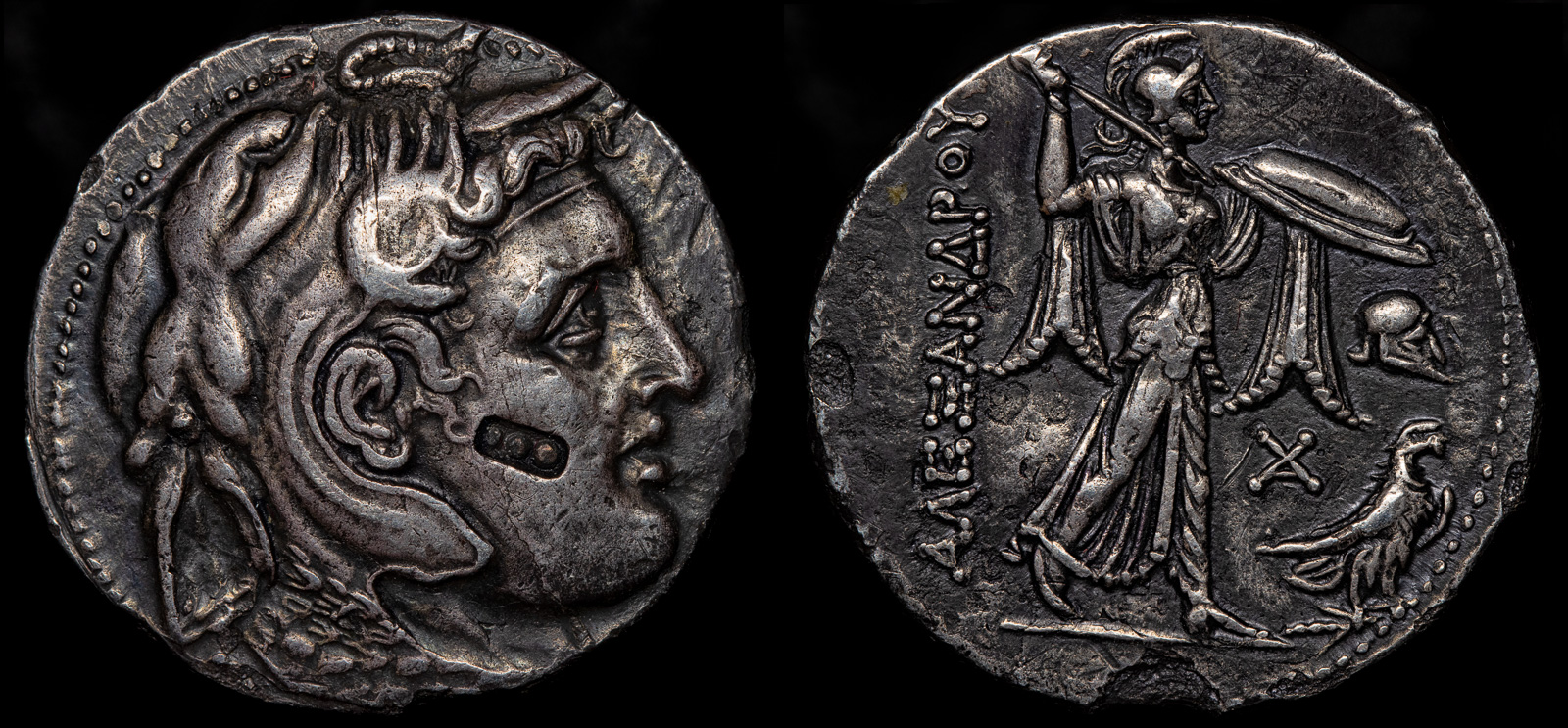
Ptolemy I
311-305 BCE
Alexandria
27.5 mm 14.6g 1h
Avers : Buste cornu et diadémé d’Alexandre le Grand sous les traits de Zeus-Ammon à droite, coiffé de la dépouille d’éléphant avec l’égide.
Revers : Athéna Promachos ou Alkidemos marchant à droite, brandissant une javeline de la main droite et tenant un bouclier de la gauche ; dans le champ à gauche, un casque corinthien, un monogramme et un aigle sur un foudre tourné à droite.
Sv.162 (37 ex) – Cop.29 – GC.7750 var. – BMC.- – MP.6
Ex Robert J. Myers Auction 12, lot 291 (December 4, 1975)
Alexander the Great founded many cities with his own name (and reputadly two named for his horse), but none ever exceeded Alexandria in Egypt for their grandeur.
One of the world’s first massively planned cities, Alexandria was laid out in a then novel grid plan that was architected by Dinokrates of Rhodes. The same architect also designed the second Temple of Artemis in Ephesos, which was one of the seven ancient wonders of the world. Another of those wonders, the Pharos, would eventually be built next to Alexandria.
When Ptolemy took over Egypt, he moved its capital to Alexandria and it was then the city really began to flourish. Although it was far from being planned that way, Alexander the Great’s body was eventually moved to Alexandria, where notable figures in history such as Julius Caesar later visited it.
During the reign of Ptolemy II, the city became among the leaders of the world. The great library was built there, long considered the greatest center of learning the world has ever known. He also finished the Pharos, a lighthouse named for the promontory on which it stood. The name ‘pharos’ has since become the word for lighthouse in numerous languages.
During the Roman Empire, Alexandria was second only to Rome in importance. During the time of the great Egyptian Pharaohs, not much was built in the area of Alexandria. It was instead a port for foreign traders, who the Egyptians wished to keep separate from themselves.
Strabo, who described most cities in a single sentence or a fragment, spent some time describing Alexandria and the area around it, and he must have spent some time there. He describes its exports as “greater than its imports” and marvels at its wealth.
April
Alexandria, Egypt founded by Alexander the Great.
June 30
Partition of Babylon. Abydos and Adramytteion come under control of Leonnatos. Egypt with Alexandria and Gaza are under Ptolemy. Baktria comes under Seleukos I Nikator. Asandros obtains Caria. Laomedon receives Koele-Syria.
Ptolemy diverts the funeral carriage of Alexander the Great to Alexandria. Archon may have colluded with him on this.
Pyrrhos is taken as a hostage to Alexandria in an arrangement between Demetrios Poliorketes and Ptolemy I Soter.
Pyrrhos marries Antigone, the stepdaughter of Ptolemy I Soter, in Alexandria.
Demetrios of Phaleron travels to the court of Ptolemy I Soter in Alexandria.
Ptolemy II takes power in Alexandria. He is believed to have founded the Library of Alexandria.
Berenike III installs Ptolemy XI as co-regent of Egypt. He then murders Berenike III and is subsequently lynched in Alexandria. Ptolemy XII becomes king.
September 29
Pompey arrives in Alexandria and is killed.
October 2
Julius Caesar arrives in Alexandria and supports Kleopatra VII over her brother, Ptolemy XIII.
Julius Caesar lays siege to Alexandria.
December
Julius Caesar and Kleopatra are besieged in Alexandria by Ptolemy XIII and Arsinoe IV.
March
The forces of Julius Caesar are relieved in the Siege of Alexandria.
Octavian (later Augustus) enters Alexandria and annexes Egypt into the Roman Empire. Cleopatra VII commits suicide, ending the Ptolemaic Dynasty.
Violence between Jews and Greeks in Alexandria over the visit of King Agrippa I results in numerous synagogues being desecrated.
Approximate year of the death of Philo,a reknowned Jewish Philosopher, in Alexandria.
July
Vespasian is the first emperor since Augustus to visit Egypt. He stays in Alexandria.
The Diaspora Revolt results in major damage to Alexandria and the near annihilation of its Jewish community. Trajan uses the occasion to rebuild the city.
Emperor Marcus Aurelius visits Alexandria and addresses the city’s citizens during his reign.
Caracalla visits Alexandria and feels insulted by the locals, so he orders all men of arms-bearing age to be executed.
Queen Zenobia of Palmyra briefly controls Egypt, including Alexandria, during her revolt against Rome, but Emperor Aurelian recaptures the city later that year.
Pompey’s Pillar erected in Alexandria to honor Diocletian.
The Arian controversy begins, with the priest Arius in Alexandria challenging orthodox Christian teachings about the nature of Christ. This theological debate has widespread implications for Christianity across the Roman Empire.
Council of Nicaea is convened by Constantine to address the Arian controversy. Athanasius, a key figure from Alexandria, emerges as a defender of orthodox Christianity against Arianism.
Athanasius becomes Bishop of Alexandria, playing a central role in the Arian controversy and in shaping early Christian doctrine.
Constans and Constantius II hold the Council of Serdica to settle a dispute over the bishop Athanasius of Alexandria. There is no agreement.
Constantius II and Constans nearly start a civil war, until Constantius allows Athanasius to return to his position in Alexandria.
Athanasius is exiled from Alexandria by Emperor Constantius II due to his opposition to Arianism.
July 21
Athanasius dies in Alexandria, leaving a lasting legacy as a defender of Nicene Christianity against Arianism.
Theophilus, the Patriarch of Alexandria, orders the destruction of pagan temples in Alexandria, including the Serapeum, as part of the rising Christian influence and suppression of paganism following Emperor Theodosius I’s edicts against pagan worship.